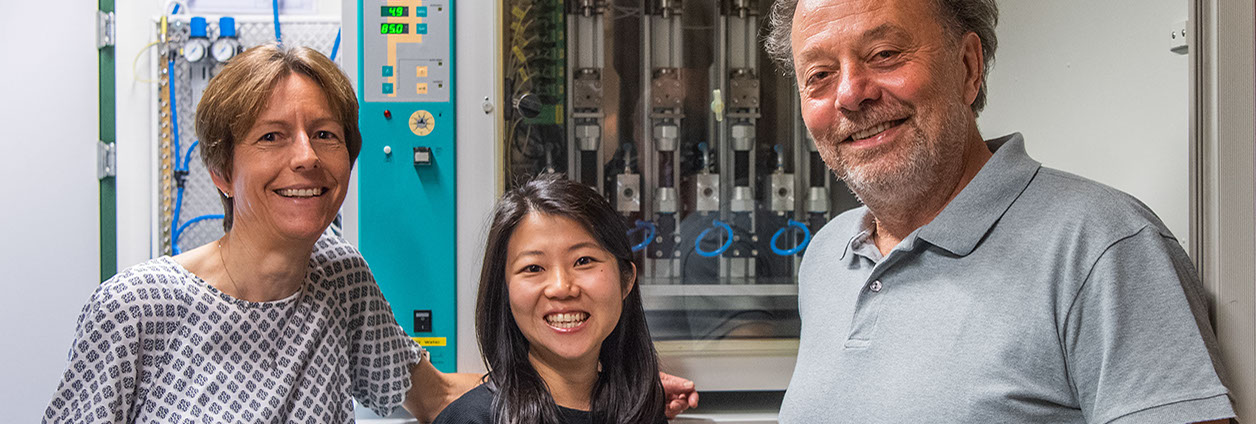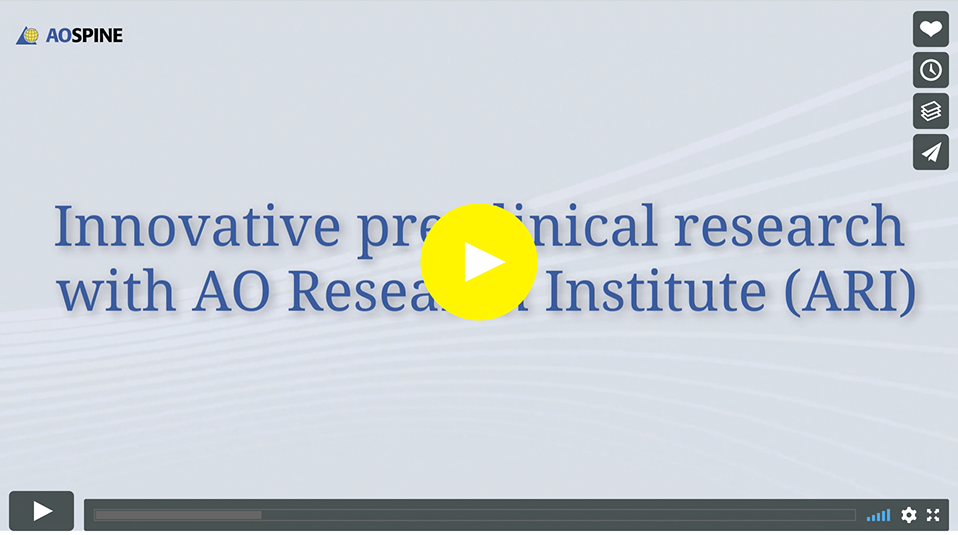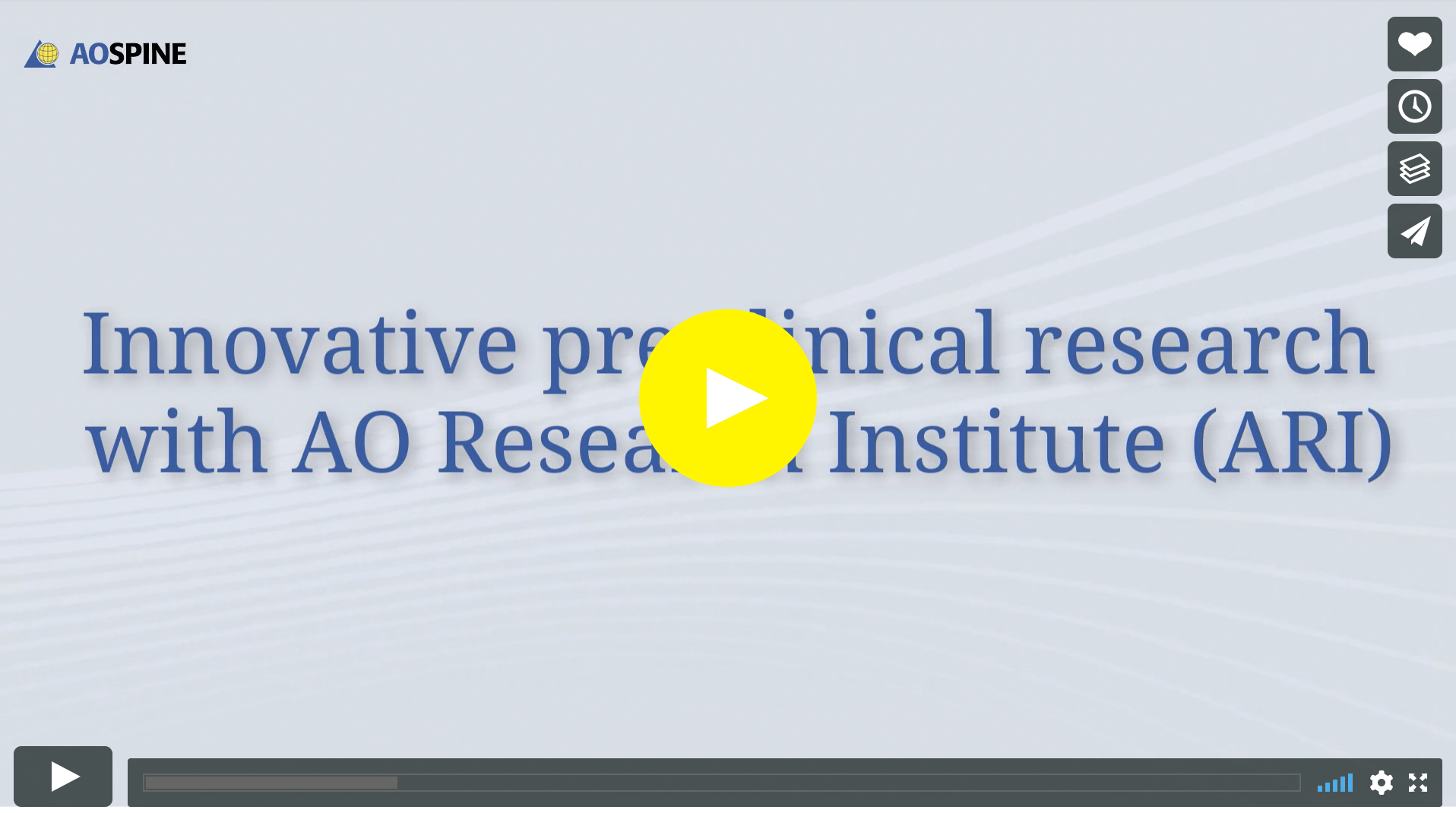
Back to basics—clinician meets basic science
Newsletter 23 | November 2019
Menu
ARI spine researchers Sibylle Grad, Zhen Li, and Mauro Alini believe certain spine diseases could be explored deeper on the molecular level to find efficient diagnostic tools.
Back to basics—clinician meets basic science
AO Spine and AO Research Institute (ARI) collaborate in innovative applied pre-clinical studies to achieve more effective patient care worldwide. Focus is on regeneration of the spinal column and postoperative spinal infection. The validation of a new bioreactor for standardized pre-clinical biological assessment is also underway.
In terms of organ culture experiments, AO is at the international forefront and a favored consortia partner for studies on new cell therapies. Mauro Alini, ARI Program Head and AO Spine Research Commission member, recalls his first ARI spine study more than 20 years ago, developing his first organ culture system known as a bioreactor with Cindy Lee, James Iatridis, and later Keita Ito. “Already then, we built ARI is the first to be validating such an innovative bioreactor system reproducing the conditions of the human spine.one of the first organ cultures and were able to culture entire motion segments with the vertebral body, disc, and end plate.”
Today, ARI’s advanced ex-vivo bioreactor systems allow using even more complex structures and organ culture models to test new approaches. Principal Scientist Sibylle Grad explains the clinically relevant setting means “we could, for example, include pain markers analyses and measurements in our organ culture systems, or test new biomaterials such as the hydrogels ARI is developing.” In addition, certain animal studies would no longer be needed when testing new therapies. They are the first group to be validating such a system.
Closer to the patient—precision medicine
One of the ARI spine studies looks at a new way to deliver mesenchymal stem cells. Alini believes homing could be a new way to deliver stem cells without injuring the disc and could serve as a means of prevention. “Homing is naturally present in young people and happens normally in most tissues. It would be interesting to apply this stem cells migration potential in certain surgeries—for example in the adjacent disc of a degenerated disc, which is replaced by cage or is fused—where we know that the adjacent one tends to degenerate in a few years,” Alini says.
“We could integrate panels of biomarkers and combine them with imaging tools for a more comprehensive diagnostic approach.”
Alini is also excited about the current Immunospine project, which hypothesizes a correlation between the patient’s preoperative immune status and the occurrence of a postoperative spine infection. The pilot phase will be finished by the middle of the next year.
Turning to the immediate future, Grad sees vast prospects: “We could measure not just one biomarker but integrate panels of biomarkers and combine them with imaging tools for a more comprehensive diagnostic approach.” Patient-specific healthcare and precision medicine is the future, but Grad is quick to remind of the responsibilities. “We must take ethical questions and data protection very seriously. The data does not belong to us, but to the patient.”
Crossover—where innovation happens
Alini is pleased there is crosstalk between the pre-clinical and clinical research bodies within AO. “It’s very important in the long-term, and to keep new generations of surgeons interested. Novelty comes from where clinicians meet basic scientists and vice versa, where there is real collaboration between all contributors in the spine world.”“Novelty comes from where clinicians meet basic scientists and vice versa, where there is real collaboration between all contributors.”
Alini encourages AO Spine clinicians to participate in these discussions and interact with basic scientists. “There are many clinical issues that can be tackled with a fundamental approach, such as the immune system, something we are heavily involved in. It plays a major role in regeneration and infection.”
Close collaboration is needed also on new biological approaches to apply treatments, such as stem cells. “At the end of the day, it’s the clinician who will use new treatments on patients,” Alini reminds. He envisions working groups, where clinical problems and topics could be discussed and brainstormed amongst basic scientists and clinicians.
Grad also expects growing collaboration with clinics. “We have already started with ethical approvals to be able to measure patient blood samples or even tissue samples, to analyze them in the lab. We have huge capacity at the AO to analyze biomarkers, to develop better diagnostic tools, and to combine basic science with clinical translation.”
Selection of recent ARI Spine publications: Peroglio M, Gaspar D, ZeugolisDI, Alini M.Relevance of bioreactors and whole tissue cultures for the translation of new therapies to humans.J OrthopRes 36(1): 10-21, 2018.
D’Este M, Eglin D, Alini M.Lessons to be learned and future directions for intervertebral disc biomaterials. Acta Biomater15; 78:13-22, 2018.
Navone SE, Peroglio M, Guarnaccia L, Beretta M, Grad S, Paroni M, Cordiglieri C, Locatelli M, Pluderi M, Rampini P, Campanella R, Alini M, Marfia G.Mechanicalloadingofintervertebral discmodulatesmicrogliaproliferation, activation, and chemotaxis. Osteoarthritis Cartilage 26(7): 978-987, 2018.
Wangler S, Menzel U, Li Z, Ma J, Hoppe S, Benneker LM, Alini M, Grad S, Peroglio M.CD146/MCAM distinguishes stem cell subpopulations with distinct migration and regenerative potential in degenerative intervertebral discs. Osteoarthritis Cartilage 27(7):1094-1105, 2019.

